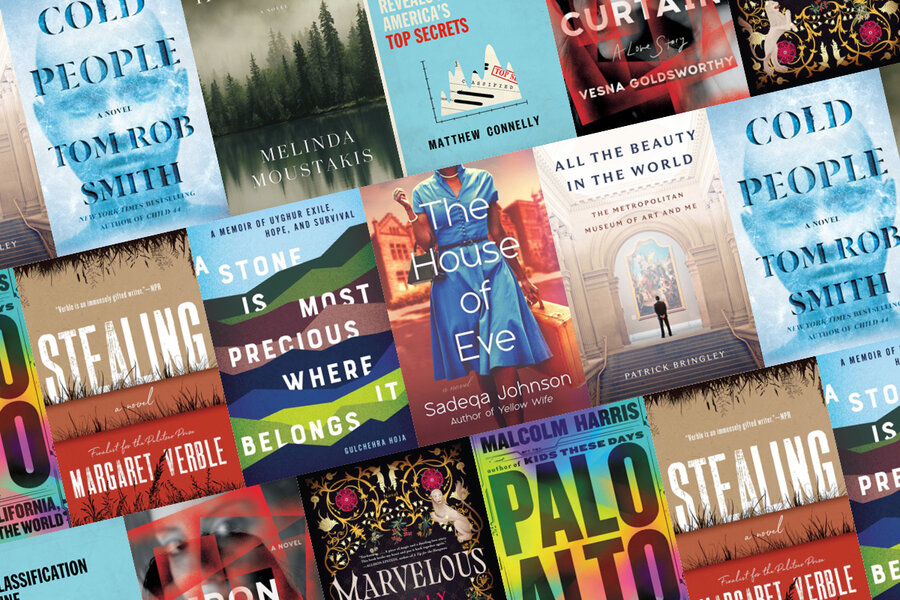Strength and purpose anchor the 10 best books of February
Loading...
1. Homestead, by Melinda Moustakis
Melinda Moustakis’ clear prose runs like a river through the lives of an ex-soldier and his bride who homestead 150 acres of Alaskan wilderness in the 1950s. Moustakis’ storytelling is both tranquil and turbulent, as she immerses the reader in the breathtaking landscape and the couple’s struggle.
2. The House of Eve, by Sadeqa Johnson
Why We Wrote This
A story focused onStories of daring and tenacity dominate our reviewers’ picks for the 10 best books of February. They include tales of fears conquered, truths told, and voices found.
In the 1950s, two Black women – high school student Ruby and college history major Eleanor – fall for men who threaten to derail their dreams. Sadeqa Johnson’s compassionate, cleareyed, and sometimes graphic page turner examines how women in desperate situations respond and move forward.
3. Stealing, by Margaret Verble
“I love my family, and I’m going to get to them as soon as I can,” promises Kit, a girl whose close ties to her mother’s Cherokee family are cut when she is dispatched to an abusive Christian boarding school in the 1950s. Kit chronicles the events leading to her removal from family, home, and community. Frank and fearless, the novel is a portrait of perseverance.
4. Cold People, by Tom Rob Smith
What if Antarctica was humanity’s new – and only – home? Scientists, alarmed by the prospect of humankind’s extinction, set out to engineer a strain of people who can survive the harsh climate. The secret project, dubbed Cold People, sparks concern as whispers of its successes, and failures, spread. Tom Rob Smith explores the tangled relationship between innovation and ethics.
5. Iron Curtain, by Vesna Goldsworthy
The privileged daughter of a Communist apparatchik falls in love with a visiting English poet and follows him beyond the Iron Curtain to 1980s bohemian London. Vesna Goldsworthy’s dramatic tale sparkles with intelligence, wry wit, and warmth.
6. Marvelous, by Molly Greeley
Molly Greeley draws inspiration from the Renaissance-era true story that inspired “Beauty and the Beast” in this extraordinary, grownup reimagining of the tale of an outcast longing for love.
7. A Stone Is Most Precious Where it Belongs, by Gulchehra Hoja
Gulchehra Hoja’s vivid memoir tells of her trajectory from growing up as an Uyghur child to hosting a Chinese children’s TV show to becoming a journalist in America. Rising numbers of Uyghurs, a Muslim minority in China, have been detained in what the government calls “reeducation” camps. While on a trip outside China, Hoja discovers reports by Uyghur dissidents about the scale of oppression in China. She gets a job with Radio Free Asia in the United States, vowing to be a voice for her people.
8. The Declassification Engine, by Matthew Connelly
Columbia University historian Matthew Connelly has written a gripping and sobering account of the exponential increase in government secrets. He persuasively argues that the United States needs a new strategy to handle classified material, demonstrating that both our national security and the health of our democracy are at stake.
9. All the Beauty in the World, by Patrick Bringley
Patrick Bringley quit his job at The New Yorker and became a guard at the Metropolitan Museum of Art in New York, a position he held for a decade. His moving and illuminating debut reveals the inner workings of the massive institution while also exploring the healing power of art.
10. Palo Alto, by Malcolm Harris
Palo Alto has been characterized as a “postmodern El Dorado,” the wealthy, happy, advanced heart of both Stanford University and Silicon Valley. In these lively pages, Malcolm Harris provides counterweight to that modern mythology, painting a far more detailed and complicated picture of the entire region, and exploring the social and economic inequalities that are often glossed over in other accounts.





